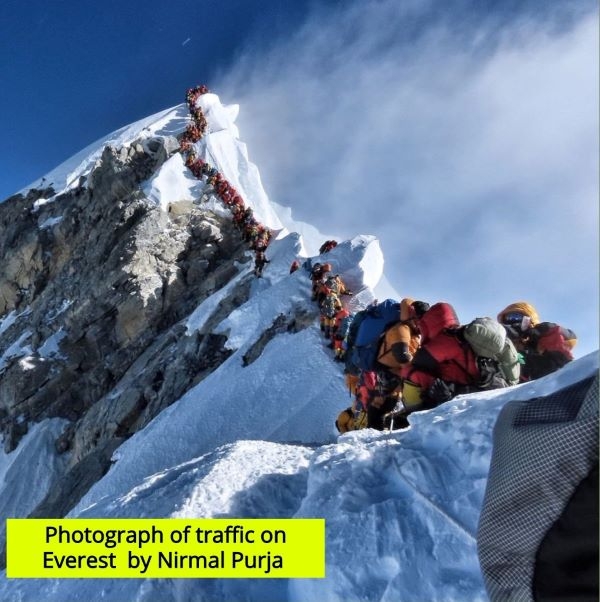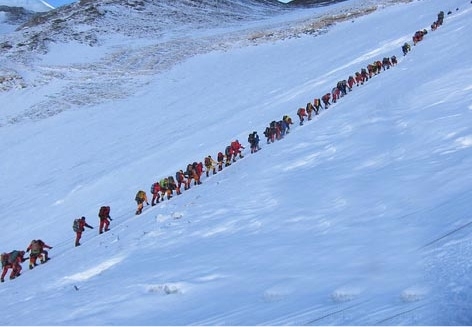Is Mount Everest becoming Death Zone? Recent ‘Crowded’ Pictures are Worrisome
New Delhi, May 25: One day, a person asked Sir Edmund Hillary, the first man in the world to climb Mount Everest, World’s Highest Peak, “Why you are doing all these stuffs? What you gain from climbing to such a height with fatal risk?”
Edmund Simply replied, “I came to know there exists something like Mount Everest somewhere on earth. I felt let’s see what it is and I climbed. That’s it!”

Today, not a single inch of earth has remained undiscovered. World’s wonderful places have been discovered out of the curiosity flaming inside human heart and the Mount Everest, the world’s largest summit is no exception to it. However, when the curiosity turns into fashion, it brings nothing but the chaos, disorder and excessive human pressure on that place. Our holy temples is the best example of this where crowd knows no bounds. In recent times, National Parks, which are in fact created for wildlife conservation, are being put too much pressure by excessive wildlife tourism.
Mount Everest now-a-days is experiencing the same kind of phenomenon. Recent photographs taken by some trekkers show the reality of the newly emerged trend of tourism on the summit and the photographs are attracting the attention of the world. One can easily see a long queue of hundreds of people waiting for the fore person to move. We wonder when we see such photographs but the guides inform that this has now become very common.
This is not a very recent phenomenon in fact. A story published in National Geographic Magazine in 2012 by the mountaineer Mark Jenkins describes the evidence-based picture of the crowd and garbage pressurizing the region. In this story mark has mentioned that on his way to the summit he found lot of dead bodies. His guide Sherpa Pannuru told him that only half the people have the experience to climb the mountain and the half without the experience are about to die. Mark further adds that ‘too often it’s not the mountain’s harshness that kills climbers but their own hubris.’
Mark further states that in 1963 when James Whittaker, the first American reached the summit, there were only 6 people reaching the top. And after 50 years, in 2012 more than 500 mobbed the summit.
Recent photographs by trekkers reveal that the situation is worsening day by day. A photograph by a renowned mountaineer Nirmal Purja is going viral on social media which shows that the reality is lot more crowded. As expeditions are getting more and more popular, it is adding more to the crowd. Norbu Sherpa, who has climbed the summit seven times informs that it is much more crowded from the Nepali side and not from Tibet side because as it is easy to climb from Tibet Side, people don’t find it ‘adventurous’. Besides, Chinese government issues fewer permits. There can be two lines of people-one going up and the other going down but everyone is hanging onto the single available rope, Norbu informs.

Alan Arnette, a summit coach states in his blog that there have been 15 deaths across six 8000-metre peaks. Number of deaths have increased because the winds have returned plus the routes are extremely crowed on both sides due to few summit weather windows this spring. Normally, there are between 7 to 12 good weather days for summit opportunities. Last year, 2018, was unprecedented with 11 straight days of manageable winds that allowed for a record number of summits. This year 2019, there have been only windows thus far consisting of five summit days and the winds and the winds were forecasted to return on Friday afternoon.
Climbing Mount Everest has become a booming industry in Nepal and boosted its economy. One has to pay $ 10,000 to $ 50,000 to get the permit. Anyone having a pocket full of money could sign up with one of the many tour operators that arrange trekking trips. According to some experts, because some people might have up to tens of thousands of dollars to take part in the challenge, climbers are taking risks even when conditions are poor and time is running out for them to ascend.
Ultimately, any famous place in any part of the world has certain capacity to accommodate human interference. If we cross that limit it not only poses threat to the ecosystem of that place but also to human being. This is the current scenario of Mount Everest. This scenario and the other likely scenarios are the signals that make us rethink on the craze of tourism.